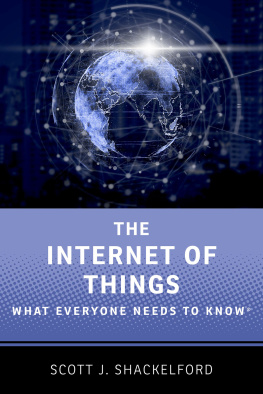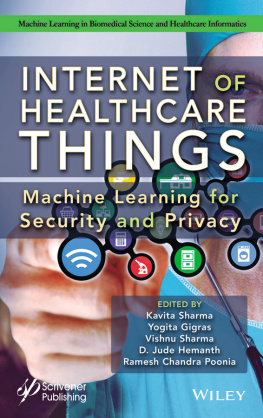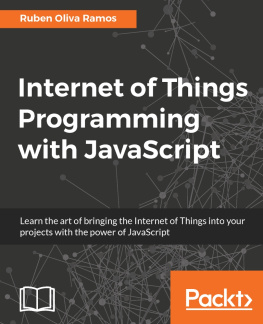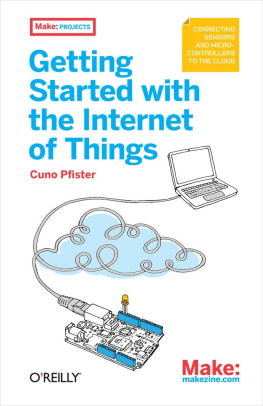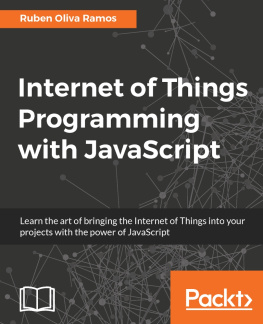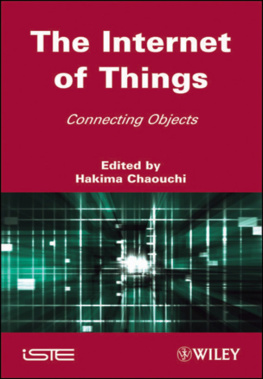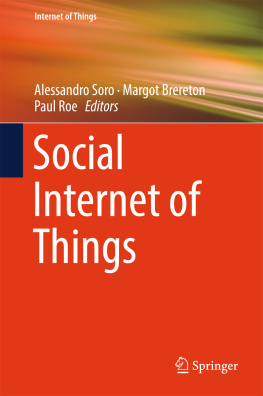THE INTERNET OF THINGS
WHAT EVERYONE NEEDS TO KNOW

Oxford University Press is a department of the University of Oxford. It furthers the Universitys objective of excellence in research, scholarship, and education by publishing worldwide. Oxford is a registered trade mark of Oxford University Press in the UK and certain other countries.
What Everyone Needs to Know is a registered trademark of Oxford University Press.
Published in the United States of America by Oxford University Press
198 Madison Avenue, New York, NY 10016, United States of America.
Published in the United States of America by Oxford University Press
198 Madison Avenue, New York, NY 10016, United States of America.
Oxford University Press 2020
All rights reserved. No part of this publication may be reproduced, stored in a retrieval system, or transmitted, in any form or by any means, without the prior permission in writing of Oxford University Press, or as expressly permitted by law, by license, or under terms agreed with the appropriate reproduction rights organization. Inquiries concerning reproduction outside the scope of the above should be sent to the Rights Department, Oxford University Press, at the address above.
You must not circulate this work in any other form and you must impose this same condition on any acquirer.
Library of Congress Cataloging-in-Publication Data
Names: Shackelford, Scott J., author.
Title: The Internet of things : what everyone needs to know / Scott J. Shackelford.
Identifiers: LCCN 2019038627 (print) | LCCN 2019038628 (ebook) |
ISBN 9780190943813 (hardback) | ISBN 9780190943806 (paperback) |
ISBN 9780190943837 (epub) | ISBN 9780190943820
Subjects: LCSH: Internet of things. | InternetSocial aspects. |
InternetSecurity measures. | Information society.
Classification: LCC TK5105.8857 .S53 2020 (print) | LCC TK5105.8857
(ebook) | DDC 004.67/8dc23
LC record available at https://lccn.loc.gov/2019038627
LC ebook record available at https://lccn.loc.gov/2019038628
To Cora
Contents
Tables
Figures
What about your heating and air-conditioning and security systems? Now, do you know what data each of these devices is busily recordingor how that data is used or protected? What about the device itselfdo you trust it to function consistently and safely? Does it matter?
There is a great deal of buzz surrounding the Internet of Things (IoT), which is the notion, simply put, that nearly everything in our physical worldfrom gym shorts to streetlights to baby monitors, elevators, and even our own bodieswill be interconnected. In other words, the IoT focuses on the smart devices pervading our homes and workplaces, while the IoE considers not only these products but also their impacts on business, culture, and society. It blurs the lines between the real world and cyberspace, creating a single, hyper-connected reality flush with both new opportunities and risks.
As the tech pioneer Kevin Ashton has said, What the Internet of Things is really about is information technology that can gather its own information. Often what it does with that information is not tell a human being something, it [just] does something. But such an outcome is also not a foregone conclusion given concerns over widening digital divides fueled in party by debates over 5G rollout.
The rise of IoT devices and services and the embedding of increasing intelligence, such as in self-driving cars,
Part of the reason the IoE presents such a mind shift is the enormous amount of data being generated, stored, and processed. According to former Federal Trade Commission chairwoman Edith Ramirez, Were now in a world where data is being collected all the time... Were bringing these devices into our homes, into what used to be private spheres, and the data that is being generated is increasingly much more sensitive. Its really in my mind fundamental that consumers continue to be in the drivers seat, that they have a say in their own information and how its being used.
We are swimming in a sea of Big Data, and its rapidly getting both wider and deeper. One way to begin to wrap your head around its vastness is to think about our smartphones. While generally not considered IoT devices themselves, smartphones are often a critical part of the IoT ecosystem, allowing users to interact with and control IoT devices through apps. More than three quarters of Americans had smartphones as of 2018the same year that half of US households had tablets, and 20% had smart speakers.
Such information, it almost goes without saying, would be of interest not only to marketers but also to criminals, and even provide a new dimension to domestic disputes.
Such statistics and examples related to the rise of smart consumer devices tell only a part of the story.
Beyond the new capabilities and opportunities that an ever-expanding Internet of Everything presents, we
In the context of IoT and more broadly, cyber attacks are continuing to increase in cost and complexity, Some scenarios with smart ovens might also be catastrophic.
Consider that, in 2014, for only the second time in history to that point, a cyber attack was confirmed to have caused physical damage.
Whether cybersecurity and data protection will scale along with IoT devicesor whether low-cost imperatives, increasing complexity, or other challenges will derail progress and exacerbate insecurityremains an open question.
Yet, for all the press that the IoT and broader but intersecting cybersecurity and privacy topics have received, it remains a topic little understood or appreciated by the public. One 2014 survey, for example, found that fully 87% of respondents had never even heard of the Internet of Things.
The goal of this book is not necessarily to let readers know everything about IoT that they wanted to know but were afraid to ask, but it aims at least to unpack some of the outstanding security, privacy, ethical, and policy challenges and opportunities in play. In essence, The Internet of Things: What Everyone Needs to Know is intended to be true to this series by providing real-world examples and straightforward discussion about how the IoT and IoE are impacting our lives, organizations, and nationsand about how they are increasingly shaping the international community in the twenty-first century. What are some of the benefits of increasingly ubiquitous IoT sensors? Is my smart speaker always listening, even when it appears to be turned off? Are there any downsides to my phones being able to unlock my front door, start my car, and control my thermostat? Can someone really take over my connected car? How are other countries working to protect user privacy? This book answers these questions and more, along with offering practical ideas about how to build an IoE that is as secure, private, innovative, sustainable, and yes, even as fun as possible.
There is certainly a lot of ground to cover, and this book covers topics from the practicalities of navigating the IoT, such as understanding the utility of the Consumer Reports Digital Standard, to wrestling with the big questions, such as the meaning and promise of cyber peace. This is done, beginning in , which is entitled Cyber-What, by charting out a hopefully helpful guide to the lay reader on the big questions of cybersecurity and Internet governance, such as: What is cyberspace? How has it expanded, and what are some of the major policy issues that are driving its evolution?

